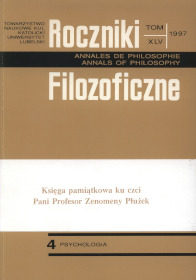The Image of Partner versus his Attractiveness
Abstract
The paper seeks to identify such attributes of a partner's image which are essential for his or her attractiveness. It is assumed here that the quality of those attributes depends on sex and the level of self-acceptance of the person who evaluates that image and on the partner's attractiveness. The analysis takes into account individual attractiveness of the partners, as different from a possible attractiveness of the diad formed by them (cf. Prężyna 1996).
The solution to the problem was sought in empirical research. The image of partner was examined by means of the Adjective Check List (ACL) in its 37-scale version. The Scale of Attractiveness (SKAT), as worked out by Nęcki (1975), was employed to study attractiveness. The subjects (120) were men and women (60 mixed diads), who had known each other for at least two years. The mean was 26.2 years. The subjects were graduates of secondary schools (62%) or universities (38%). They were married (48%) or single (52%).
The findings have confirmed the thesis about a broad relationship between the level of attractiveness and the attributes (31 out of 37 subjects) of the partner. It has turned out that the most important source of attractiveness is the image of partner, when it is evaluated by a woman, and when the evaluating person – woman and man – is characterized by a higher level of self-acceptance (cf. tab. 1). Furthermore, an analysis of multiple regression (cf. tab. 2) has allowed us to state that a particular dimensions of the image under study are more interrelated when that image is perceived by a woman. The groups consist then of a larger number of dimensions, are qualitatively different than in the case of a man, and explain the bigger percentage of variations of attractiveness (for the woman of a low self-acceptance – 83% and 88%, with high self-acceptance; and for a man 76% and 70% respectively.
Finally, comparing the relationship between the image of partner with his individual attractiveness, as perceived by a woman and a man, and the attractiveness of the diad created by the partners, one may deduce that attractiveness perceived by the woman has a greater influence on making the diad more attractive.
References
Cash Th. F., Janda L. H., Byrne D., Murstein B. I., Merighi J. R., Malloy T. E. (1994). Interpersonal Attraction. W: A. Wayne, A. Lesko (red.), Readings in Social Psychology: General, Classic and Contemporary Selection. Boston.
Juros A., Oleś P. (1993). Struktura czynnikowa i skupieniowa Testu Przymiotnikowego ACL H. G. Gougha i A. B. Heilbruna. W: J. Brzeziński, E. Hornowska (red.), Z psycho¬metrycz¬nych problemów diagnostyki psychologicznej. Poznań.
Nęcki Z. (1975). Psychologiczne uwarunkowania wzajemnej atrakcyjności. Wrocław.
Nęcki Z. (1990). Wzajemna atrakcyjność. Warszawa.
Prężyna W. (1996). Obraz siebie i partnera a wzajemna atrakcyjność. Roczniki Filozoficzne, 44 (4), 75-133.
Rauste von Wright M., von Wright J. (1985). Obraz własnej osoby a postrzeganie ludzi. Prze¬gląd Psychologiczny, 3, 687-698.
Copyright (c) 1997 Roczniki Filozoficzne

This work is licensed under a Creative Commons Attribution-NonCommercial-NoDerivatives 4.0 International License.





